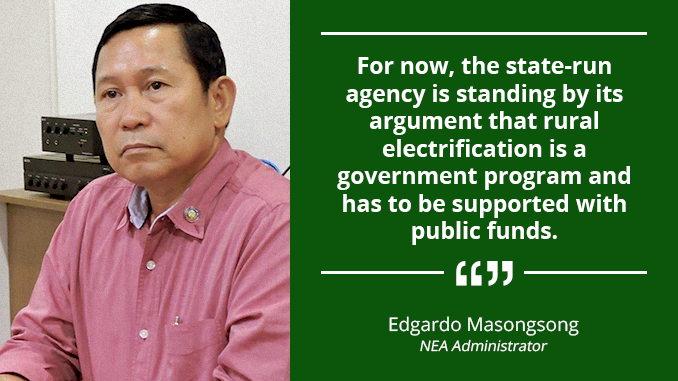Some 290 representatives from 113 electric cooperatives (ECs) participated in a two-day Electricity Forum this week at the National Electrification Administration (NEA) building in Quezon City to shed light on several issues confronting their industry.
Taking center stage in the agenda is the proposed policy that would allow private investors to install microgrid systems in EC coverage areas that are yet to be energized or where electricity service is considered unreliable.
NEA Administrator Edgardo Masongsong wanted to ascertain if the power cooperatives and their member-consumer-owners are amenable to this kind of arrangement if only to speed up the implementation of the rural electrification program (REP).
The discussion was sparked by their alleged failure to provide adequate service in some areas as pointed out by Senator Loren Legarda, chair of the Senate Committee on Finance, while deliberating last month on the proposed P4.9-billion budget of the NEA for 2018.
The state-run agency acknowledged this notion and thus required the ECs to submit updated data on remote households or sitios within their coverage areas that remain either unenergized, unserved or underserved.
“Ang reality, matagal na tayo dito, matagal na tayong electric cooperatives – in fact, the ECs have been in existence for the last 30 years up to 48 years—pero bakit daw kailangan pa rin ang gobyerno maglaan ng pera para sa electrification?” Masongsong told the general managers and board of directors present.
“Kaya kailangan maglabas tayo ng policy na kung hindi kaya ng ECs i-energize ang mga remote, unenergized, unviable, underserved areas that should be considered waived,” the NEA chief said.
Lawyer Goldelio Rivera, the NEA Deputy Administrator for EC Management Services, clarified however that the waiver being sought was only temporary and is limited to the “rights and obligations” of an EC to provide electricity service over certain areas.
“We are very clear that what is to be temporarily waived is the rights and obligations to provide (electricity service) not the franchise because the franchise is within the domain of Congress,” Rivera explained.
Basically, the new policy will be following the same principles as the Qualified Third Party (QTP) mechanism of the Department of Energy (DOE) for investors who are interested in putting up power generation and distribution facilities in the far-flung areas.
As expected, the proposed guidelines received mixed reactions from the stakeholders. Some EC general managers supported it while others had reservations, citing fears that it might lead to unfair competition in the long run. There are also doubts that private companies would be willing to invest on economically unviable areas.
Masongsong took all these comments into account and asked the National Association of General Managers of Electric Cooperatives (NAGMEC) president Sergio Dagooc to come up with a final draft of the ECs’ collective stand on the issue.
The administrator said he is expecting their output in two weeks before the NEA finalizes its proposed guidelines. For now, the state-run agency is standing by its argument that rural electrification is a government program and has to be supported with public funds.
“If government will not fund it, will not subsidize it, then the dream of achieving 100 percent electrification in the country will never be realized unless the private sector will really invest in it even if it’s a losing proposition,” Masongsong said.

